|
Tree maintenance and Sun Seeker...
Scott Bordner, RiverCrest Country Club, Phoenixville, PA:
 "Trees complicate things on a golf course for several reasons. I will summarize the areas and explain the reasoning for tree removal.
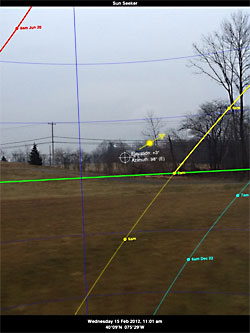
Sunlight
One of the main reasons for tree removal is that they block a lot of sunlight. Allowing the plant to receive morning sun, especially during the spring and fall months, is essential for photosynthesis.
Damaged
A more obvious reason for tree removal is when they have experienced damage from insects or disease. We inspected nearly every tree on the course last season and believe we have adequately addressed this problem.
Aesthetics
We removed a limited amount of trees for this reason. Before the Club opened, we were unable to finish clearing out the small tree lines that lie adjacent to many holes on the course. This has been an ongoing project since 2005. While the removal of these trees offers a cleaner look to the course, it will also allow golfers to take full back swings when hitting out of the area. It will also promote a healthier environment for the specimen trees in those areas.
Maintenance Efficiency
From April to November, my staff is busy blowing debris and leaves off of the course. Not only is this very time-consuming and sometimes intrusive to the membership, but it also negatively affects the turf in multiple ways. It also takes a toll on our equipment. Some trees were removed which are continual nuisances throughout the year (Sassafras, Ash & Black Cherry).
Overall, the selective tree removal performed this past winter will provide great benefits to the course and, in turn, the membership. I expect to see enhanced turf conditions, lower operating costs and straighter shots coming out of the tree lines this upcoming season.
 The images to the right are from Sun Seeker, an app for iPhone and iPad. The top image is after we had removed the trees on number 7. The light blue line is the sun angle on the shortest day of the year, the red line in the corner is the angle on the longest day of the year, and yellow is today. You can see by the angle and time frame that the trees removed left of the large walnut trees give us a couple extra hours of sun in spring and fall. The walnut trees are next in line and will give us even more sunlight in the shoulder seasons and in turn healthier turf.
The second image is off the back of 9 tee where we cut back the tree line to give the turf more sunlight in the summer. We gained about an extra hour of morning sun and the tree removed to the left of the tee gained us about an hour in the afternoon. This should allow the turf to dry out a bit more and survive through prolonged wet, hot periods."
Visit Scott's blog at rivercrestgolfclub.blogspot.com
|
 |
|
Evaluating Reel Motor Speed
Jason Cook, Arrowhead Country Club, San Bernardino, CA:
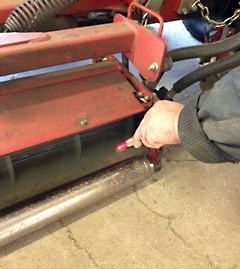
"We have been experiencing an inconsistency issue with the quality of cut of the intermediate and surround mower. The outer left unit is not producing the quality cut that we expect and is leaving a plateau appearance on the turf.
In the troubleshooting process we verified reel to bed knife relief, height of cut, bearing movement, and reel to ground speed ratio. Next on the list was to verify individual reel speed and hydraulic motor efficiency. To measure this a digital infrared tachometer is utilized. We discovered that the suspect unit was underperforming and will require further diagnostics.
Visit Jason's blog at arrowheadcountryclub.blogspot.com.
|
 |
|
Old Drainage Failing...

Jason Hooper, Q Golf Club, Quilchena, British Columbia, Canada:
"We have been experiencing some drainage issues on #9 approach for quite some time now. We have now begun investigating to determine the exact cause of the drainage concerns. Our first plan of attack was to amend the profile of the approach as soil probing indicated very high thatch levels. The best way for us to do this is by core aerating and topdressing frequently to continually improve the top 4"-6" of the profile. Conditions need to firm up to properly pull cores and achieve the desired results.
Being that the approach is so saturated, we decided to at least deep-tine aerate the area using solid tines (non-coring) to open channels for proper drainage until conditions firmed up enough to be suitable for coring. We discovered large pockets of water/air not far below the surface, which is a clear indicator that drainage tiles below are likely compromised. We have determined that the top of a drainage line is only about 10" below the surface. Being so shallow, it has likely been struck and damaged by deep tine aeration time and time again.
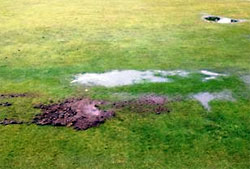
Here is photo of soil and water that rushed to the surface from one of the water/air pockets below:
We are in the process of digging up the area to expose the compromised tile and I've got good news and bad news. The good news is that the drainage installed by TDS during the course project is working just fine. The bad news is that we've discovered old drainage installed in-house well before the course project that is failing miserably. Here are a few photos of what was discovered:
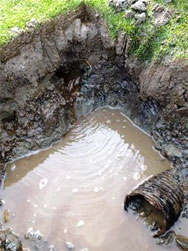
Tile connections completely severed.
|
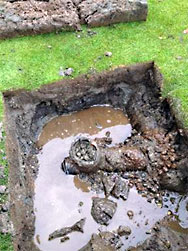
Tile completely filled with mud and gravel.
|
As you can see, the drainage lines are highly contaminated. We will continue to expose this old drain line and will then determine the best approach. I anticipate we will find the entire line to be far too contaminated to be deemed useful and if that's the case, it will need to be completely removed and properly replaced to ensure that this high profile area drains properly. A temporary green will be necessary at times for us to efficiently and safely work on fixing this problem.
I suspect that improperly installed in-house drainage is the cause of other drainage issues we are experiencing on the course.
Visit Jason's blog at qgolfclub.blogspot.com.
|
 |
|
A little knowledge from back home...
Dan Salois, Highland Meadows Golf Club, Sylvania, OH:
 "I am originally from the Pacific Northwest, more specifically the greater Seattle, WA area. As I was browsing some industry articles, I came across one from my previous USGA regional agronomist back home and was suprised to see pictures of Safeco Field (home of the Seattle Mariners). After wondering what my USGA agronomist was doing looking at sports turf, I read the article and realized it carried a great message about shade.
"Even with the amount of time, money, and scrutiny they give the field, they still struggle mightily with shade from the grandstands..." |
The amount of turf on a baseball field isn't very much compared to a golf course, but every inch of it must be perfect at all times (at least until the end of September since the Mariners can't seem to play baseball in October). Even with the amount of time, money, and scrutiny they give the field, they still struggle mightily with shade from the grandstands. Despite underground heating and cooling systems and perfect drainage and a retractable roof, the lack of sun will still kick your ass.
As a result, the crew at Safeco is experimenting with portable lights to "sun" the portions of turf that have in years past struggled and required re-sodding. This brings me to my ultimate point-shade makes growing grass difficult. Even in a relatively controlled environment in a part of the country where summer stress doesn't really exist in most years, they can't grow it in the shade.
So please read the article, it's not very long. Keep in mind the double-edged sword that are trees on the golf course, and maybe think twice if you see me thinning or removing tree canopy before cussing me out."
Visit Dan's blog at hccgcgd.blogspot.com
|
 |
|
Updates to the Storage Area
Jeff Johnson, The Minikahda Club, Minneapolis, MN:
 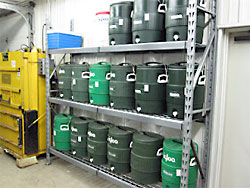
Winter is a great time of year for our department to analyze our maintenance facility and look for areas where we can improve an update the overall appearance and functionality of our space. One area that we have been looking to improve for a few years is our back storage area. This is an area that was once shared space with the Golf Staff. They utilized this area in the summer for washing and storing range balls. Now that they have a 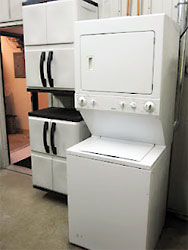 new building we have the space to ourselves.
The original shelving was installed in 1997 and was in great need of replacement. That shelving has been replaced with stronger, more supportive metal shelves. Since this area is where water coolers are cleaned and filled with water and ice the main purpose of the shelves will be to store the coolers.
What might be our best addition to the room is our new washer and dryer and storage cabinets. Typically tee towels and other assorted items that need cleaning are sent to the club house. This is not always convenient for us and we wanted to have more control over when the towels are cleaned and where they are stored. Nick was not only able to 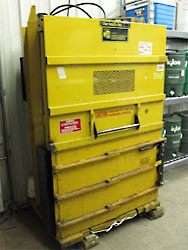 find a used unit on Craiglist but he completed all of the necessary plumbing and venting work.
A number of years ago the club was in need of a new cardboard compactor, instead of trading the old compactor, we took it off their hands and have be utilizing it in our facility for a number of years. The compactor is great to have in the building and we know all cardboard is being properly recycled.
Visit Jeff's blog at minikahdagrounds.blogspot.com.
|
 |
|
About our Blog Aggregator: Many superintendents are now hosting private blogs to better communicate with their golfers and/or members. Beyond local weather and course conditions, there is a great deal of information about projects, methodologies and techniques that would be of value to other superintendents — hence our Turf Blog Aggregator. As every blogger struggles occasionally with content, we also include posts intended to educate golfers about turf maintenance for others to use as a template for their own blogs.
Miss any previous issues of TBA? You can find them all here.
Turf Blog Aggregator(TM) is a trademark of Turnstile Media Group.
|
|